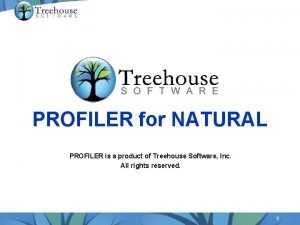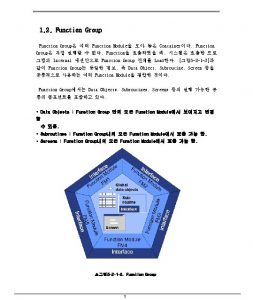Profiler and Profiler X The function of Profiler

















- Slides: 17

Profiler and Profiler. X

The function of Profiler is a tool that automates the capture of company and contact information related to a single corporate, or “entity” website. Examples include: • A company website – Albert’s Organics. (www. albertsorganics. com) • A non-profit or association website – Turnaround Management Association. (www. turnaround. org) • An educational, or government website – University of Texas Medical Branch. (www. utmb. edu ) The type of information derived from these sites can be any/all of the following: • Contact and biographical information appearing on or peripheral to that entity’s website • News articles, press releases • Backlinks - web pages, online lists and directories that the entity (and like/competitor entities) may appear on • Mission/positioning statements, and user defined keywords that appear on the site

The limitations of Profiler It’s true. Profiler can’t do everything. It’s designed to work with information-rich, publically accessible websites. Sites and information sources that Profiler was not designed to access information from includes: • Directory sites that are either password protected, “submit page” protected, or are driven by a “behind the scenes” database • “Brochure” or e-commerce, and non-corporate commercial sites (nike. com, itunes. com, ford. com) • Search, and news aggregation engines (“Google, gimme whatcha got!”) • Newsgroups, and bulletin/chat board sites

The Profiler Layout The Search Plan Area. “Plans” are folders where entity websites that the user intends to profile are organized, and stored. Menu Bar. Action Bar. Company View Grid. The Menu Bar is a drop-down menu of all settings, views and actions, allowing for keyboard navigation of Profiler. A series of action icons used to operate the core functions of Profiler. This is where a collection of companies (entities) within a specified plan will be displayed. This view can be customized to some degree. Profiler Results View. Here is where you will find the results of your Profiler research. This is an example of the Contacts View. Like the Company View Grid, this can be customized to some degree. Profiler View Tabs. Profiler has a number of views that can be displayed by selecting the appropriate tab. Filter, & Export Range. Applicable only to the Contacts View, these filter what contacts appear in the results view, and which are eligible for exporting, based on their Contact Assuredness Score. Every contact in Profiler is scored based on the revelancy, recency, frequency, completeness and location of where their data is derived from. This score, ranging from 0 -1000, reflects how confident we are that the information is accurate. Data Map. Above represents all of the sources from which the selected person’s contact information was derived. (Contact’s View. ) Daily Limit Meter. Each copy of Profiler includes a daily limit. To monitor the number of searches you have available, refer to this meter. “Bio” View. “Bios can be anything from a selected contact’s biographical information to a reference to them in a news article, or press release. (Contact’s View. )

How to get started Adjusting settings. Some commonly “adjusted” values: • Processing – the search functions Profiler attempts on every URL you initiate. (Note: Can be adjusted, but you will likely lose valuable data!) • Limits – How deep (Max homepage search), and how wide (Max pages to extract) Profiler goes into the URL you’re searching…and beyond • Options – Case, and complete names rules, update pop-ups, and the external browser option • Normalization – REALLY important in duplication identification, this setting is used to ensure that everyone putting company information into the database using Profiler, does so in the same format • Example - The Acme Widget Company Incorporated • How would you want it? ___________________ • Network – Proxy server settings, and how much bandwidth you’ll permit Profiler to use • Proxy Server is likely something your IT department may need to assist you with • Throttle Bandwidth – a maximum bandwith limit for Profiler (Note: “ 0” is wide open - don’t do this if you share your network with others. ) • Plugins – (Profiler. X users – be sure to enable the Hoover’s plugin, to access your subscription. )

How to get started Profiler needs at least one of two (three) pieces of critical data in order for you to use it. • an entity’s name, and/or • an entity’s URL • DUNS number (optional, applicable for Profiler. X) There’s a number of ways you can get this data into Profiler: • Inputting the information manually • Importing the information from an Excel spreadsheet (Import Wizard) • Exporting directly from one of Broadlook’s other tools (Eclipse, Market Mapper, Contact Capture) into Profiler

Manual entry of sites into Profiler a. Quick Search – A rapid, on-demand (100 page max) skim of the company’s website. The company and contact data will immediately be placed in the orange “Quick Search” folder. b. Full Search – Another on-demand option, this time using the maximum page, and site depth settings you’ve configured Profiler. (For information on Profiler Settings, check out the Broadlook’s beginner Profiler class. ) The company and contact information will be added to the folder you have highlighted. (In the example above, #1 Sample Data) c. Save – Use this button if you’d like to enter multiple companies into the folder, and run it in batch via the “Run Plan” button above. 1. Click the “New Search” button to initiate your manual search. 2. This will prompt the “New Search” window to pop up. Enter the company name and/or the URL of the company you wish to research. 2. 5 OPTIONAL: If you don’t have the company’s URL, click on the URL look-up button, to the right of the Company name field, this will prompt Profiler to do a search on the name across a number of search engines, and provide you with suggested URLS. 3. After entering the data into the New Search window, you now have three (3) options for conducting this manual search.

Working with your results Once you have contact data in the results grid, you can: • filter it • sort it (by columns) • fill in empty email with suggestions based existing email configurations • fill in contact phone numbers with the company’s main number Contact Icon Legend – quick view graphics to help you understand the data derived. − New contact. This is the first time you’ve found this person, in this plan. − Historical, or incomplete contact. You’ve had this contact in this company and plan before. − “Bio” or additional information. Be sure to check out the “Bio” view in the lower right corner of Profiler for additional information. − Hoovers. Some or all of this contact’s information was derived from Hoovers. − “Edgar” indicator. Some or all of this contact’s information was derived from regularly screened SEC filings. − Social Network Data. Profiler submits queries to search engines for social network data. (Check the Data map for specific references to these social networks, and profile pages. ) − Key Contact. This contact was found on what appears to be a management or executive page. − Board/Investor Relations. Contact was found on a page referencing BOD, IR, or shareholders.

Exporting the results Once you have contacts in Profiler, you can move them directly to your database (ATS, CRM, or Outlook Address), or to a document (Excel, v. Card, text, csv) through a “Quick Export” or through the “Export Wizard” • Export a single company’s contacts, or a group of companies in a plan (all or selected) • Export via title, export range, and filter criteria (“must haves” “bio” “new contacts”) You can also move contacts into Profiler’s Hotlist – an intermediate “roll-up” list • Validate the information • Append / correct data • Export to a database or document

Other views in Profiler Profile Tab. In this tab, you’ll find some basic statistics on Geography, and Demography in the right column, and the following sub-tabs. ◦ Backlinks. These are external web pages that the target URL appears on. These could contain lists and directories of competitors, or complementary companies. ◦ Whois record. The Whois registration is a database of registrations for every domain. To learn more about Whois, visit ICANN. org. ◦ HTTP Errors / URLS Tabs. The targeted website is essentially “mapped” in the URL view. In the HTTP Errors view, you’ll find a list of broken links. Events Tab. In this tab, you can build specialty searches for keywords, and key phrases that you’d like Profiler to search for within the site. Should it find these phrases of interest, it will provide you with a link back to the page. Locations Tab. This is a view of all addresses identified on the site. Should a contact be referenced with a location, their name will also be listed. About Tab. This is a study of positioning, and descriptive language used by the company/entity.

Profiler. X - Hoovers integration Profiler. X is an optional paid add-on for Profiler, and upgrades the application to include the Hoovers database in its sources. It also allows the user to be able to build a list of companies from the Hoovers database, based on reported criteria (location, employees, revenue), and allow Profiler to access web, and database content.

Enabling Profiler. X 1. On the menu bar, please click on the Tools dropdown, and click on the Settings option. 2. Next, select the Plugins tab in the pop-up window, and check off on the Hoovers Enabled check box. 3. Click the Done button, to enable access to the Hoovers directory.

Displaying the DUNS ID You may need to customize your Profiler Company Grid, to display a company’s Data Universal Number System (DUNS) ID. This is the ID that Hoovers uses for indexing / searching information. 1. In the Company grid of Profiler, click on the small Column Modify button, on the far left of the grid header. 2. In the pop-up window, locate the DUNS value, and click on the checkbox next to it. To move the DUNS column to a preferred order in the company grid, merely left click on it’s column header, and drag it to the desired location. (You can add, remove, and arrange any of the values in the grid, or grid options to your preference in this same manner. ) You are now ready to run a test profile, to make sure everything is set up, and working properly.

Sample Search 1. Start by doing a Quick Search on either this example, or on a company that you are certain is in the Hoovers directory. 2. Once Profiler has finished processing the site, look for these indicators: • A DUNS number populated in the company grid. (The DUNS number will be populated by Profiler in most cases. If this is not the case, you’ll need to do a DUNS look up. See next page) • Contacts with an “H” next to their names. (This indicates that part of their contact information was derived from Hoovers. • When a contact with an “H” is highlighted, look for the Hoovers Link, and the “Powered By Hoovers” logo.

The Hoovers Tab Once your search has completed, be sure to click on the Hoovers tab for the editorial content that Hoovers provides. • General Company, and Industry Classification Data • Reported Key, Market, and Financial Data • Other Data Views • Competitor Tab • • • TIP – the “Create Plan” button will export companies identified as competitors into a unique plan for further research. Description Industries Locations Urls Execs

Building a List, Using Hoovers Start by selecting the Hoovers Option from the Tools Menu. This will prompt the Hoovers selection window. Your initial view will be the “Quick Search” Tab. From here, you can do basic searches by keywords, city and/or US state, Hoovers Industry Sectors, and some quantitative reported data. (Use the Company Location, Key Data, Industry and Specialty Tabs for more specificity. ) Once you’ve made your selections, click on the “Search” Button to send the query to Hoovers database, for companies that fit your criteria.

Building a List, Using Hoovers You’ll find your results in this grid. If you would like to review a specific record, highlight it and click Company Details. (This is essentially the same view as the Hoovers Tab in Profiler) Otherwise, choose records, click Export to Profiler, and follow all prompts to move these company records into a Profiler Plan. Once the Download of the companies from Hoovers into a Profiler Plan is completed, “X” out of the Hoovers screen, and start running your new plan.
 Hình ảnh bộ gõ cơ thể búng tay
Hình ảnh bộ gõ cơ thể búng tay Frameset trong html5
Frameset trong html5 Bổ thể
Bổ thể Tỉ lệ cơ thể trẻ em
Tỉ lệ cơ thể trẻ em Voi kéo gỗ như thế nào
Voi kéo gỗ như thế nào Tư thế worm breton là gì
Tư thế worm breton là gì Alleluia hat len nguoi oi
Alleluia hat len nguoi oi Môn thể thao bắt đầu bằng từ đua
Môn thể thao bắt đầu bằng từ đua Thế nào là hệ số cao nhất
Thế nào là hệ số cao nhất Các châu lục và đại dương trên thế giới
Các châu lục và đại dương trên thế giới Công thức tính thế năng
Công thức tính thế năng Trời xanh đây là của chúng ta thể thơ
Trời xanh đây là của chúng ta thể thơ Cách giải mật thư tọa độ
Cách giải mật thư tọa độ Phép trừ bù
Phép trừ bù độ dài liên kết
độ dài liên kết Các châu lục và đại dương trên thế giới
Các châu lục và đại dương trên thế giới Thơ thất ngôn tứ tuyệt đường luật
Thơ thất ngôn tứ tuyệt đường luật Quá trình desamine hóa có thể tạo ra
Quá trình desamine hóa có thể tạo ra

































